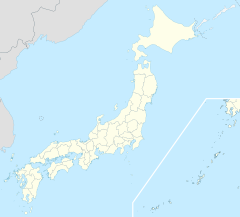
Emperor Suinin, also known as Ikumeiribikoisachi no Sumeramikoto (活目入彦五十狭茅天皇) was the 11th legendary Emperor of Japan, according to the traditional order of succession. Less is known about Suinin than his father, and likewise he is also considered to be a "legendary emperor". Both the Kojiki, and the Nihon Shoki record events that took place during Suinin's alleged lifetime. This legendary narrative tells how he ordered his daughter Yamatohime-no-mikoto to establish a new permanent shrine for Amaterasu, which eventually became known as the Ise Grand Shrine. Other events that were recorded concurrently with his reign include the origins of Sumo wrestling in the form of a wrestling match involving Nomi no Sukune.

In Japanese religion, Yahata formerly in Shinto and later commonly known as Hachiman is the syncretic divinity of archery and war, incorporating elements from both Shinto and Buddhism.

The Grand Shrine of Ise, located in Ise, Mie Prefecture of Japan, is a Shinto shrine dedicated to the solar goddess Amaterasu. Officially known simply as Jingū (神宮), Ise Jingū is a shrine complex composed of many Shinto shrines centered on two main shrines, Naikū (内宮) and Gekū (外宮).

In Shinto and Buddhism in Japan, an ofuda is a talisman made out of various materials such as paper, wood, cloth or metal. Ofuda are commonly found in both Shinto shrines and Buddhist temples and are considered to be imbued with the power of the deities or Buddhist figures revered therein. Such amulets are also called gofu (護符).

A Shinto shrine is a structure whose main purpose is to house ("enshrine") one or more kami, the deities of the Shinto religion.

Hikawa Shrine is a Shinto shrine located in Ōmiya-ku, Saitama, Saitama Prefecture, Japan. It is one of the two shrines claiming the title of ichinomiya of former Musashi Province. The main festival of the shrine is held annually on August 1. The district of Omiya, literally "Great Shrine", derives from the special favor shown by Emperor Meiji, who raised Hikawa above all other shrines in the Kantō region. It is the head of a network of approximately 280 Hikawa shrines mostly around the Kantō region.

Shizuoka Sengen Jinja (静岡浅間神社) is the name for a collective group of three Shinto shrines now forming a single religious corporation, located at Mount Shizuhata in Aoi-ku, Shizuoka, in Shizuoka Prefecture, Japan. These shrines are the Kanbe Jinja (神部神社), Sengen Jinja (浅間神社), and Ōtoshimioya Jinja (大歳御祖神社). The main festival of the shrine is held annually on April 5.

Toyouke-Ōmikami is the goddess of agriculture and industry in the Shinto religion. Originally enshrined in the Tanba region of Japan, she was called to reside at Gekū, Ise Shrine, about 1,500 years ago at the age of Emperor Yūryaku to offer sacred food to Amaterasu Ōmikami, the Sun Goddess.

Ōasahiko Shrine is a Shinto shrine in the Ōasachō-Bandō neighborhood of the city of Naruto, Tokushima Prefecture, Japan. It is one of the shrines claiming the title of ichinomiya of former Awa Province. The main festival of the shrine is held annually on November 1.

Ōmiwa Shrine, also known as Miwa Shrine, is a Shinto shrine located in Sakurai, Nara Prefecture, Japan. The shrine is noted because it contains no sacred images or objects because it is believed to serve Mount Miwa, the mountain on which it stands. For the same reason, it has a worship hall, but no place for the deity to be housed. In this sense, it is a model of what the first Shinto shrines were like. Ōmiwa Shrine is one of the oldest extant Shinto shrines in Japan and the site has been sacred ground for some of the earliest religious practices in Japan. Because of this, it has sometimes been named as Japan's first shrine. Ōmiwa Shrine is a tutelary shrine of the Japanese sake brewers.
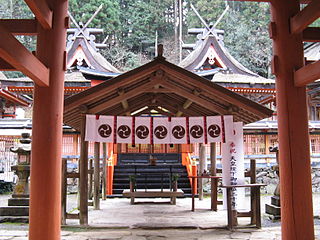
The Niutsuhime Shrine or Nibutsuhime Shrine is a Shinto shrine in located the town of Katsuragi, Ito district, Wakayama Prefecture, Japan. The shrine is one of three shrines claiming the title of ichinomiya of Kii Province. Also known as "Amano Taisha" and "Amano Shisho Myojin", it is the head shrine of about 180 Niutsuhime Shrines around the country. Its precincts are designated a National Historic Site and the shrine is one of the constituent assets of the UNESCO World Heritage Site Sacred Sites and Pilgrimage Routes in the Kii Mountain Range.
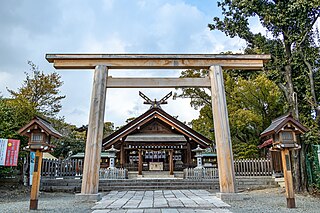
Ōtori Shrine is a Shinto shrine located in Nishi-ku, Sakai, Osaka Prefecture, Japan. It is the ichinomiya of former Izumi Province. The shrine's main festival is held annually on August 13.

Kushinadahime (櫛名田比売、くしなだひめ), also known as Kushiinadahime (奇稲田姫、くしいなだひめ) or Inadahime (稲田姫、いなだひめ) among other names, is a goddess (kami) in Japanese mythology and the Shinto faith. According to these traditions, she is one of the wives of the god Susanoo, who rescued her from the monster Yamata no Orochi. As Susanoo's wife, she is a central deity of the Gion cult and worshipped at Yasaka Shrine.

Awa Shrine is a Shinto shrine in the Daijingū neighborhood of the city of Tateyama in Chiba Prefecture, Japan. It is one of two shrines claiming to hold the title of ichinomiya of former Awa Province. The main festival of the shrine is held annually on August 10.
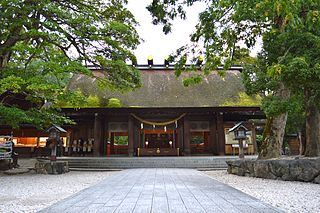
Kono Jinja (籠神社) is a Shinto shrine in the Ōgaki neighborhood of the city of Miyazu in Kyoto Prefecture, Japan. It is the ichinomiya of former Tango Province. The main festival of the shrine is held annually on April 24.The shrine is also called the Moto-Ise Kono Jinja (元伊勢籠神社), and its kannushi has been in the Amabe clan since the Kofun period.
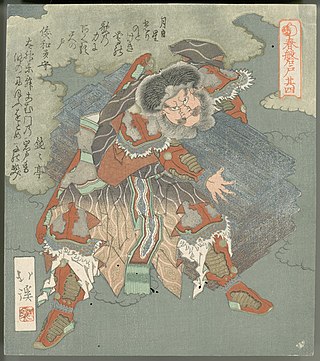
Ame-no-tajikarao (アメノタヂカラオ) is a Japanese deity (kami) who appears in Japanese mythology. Ame-no-tajikarao is written as 天手力男神 in Kojiki, and 天手力雄神 in Nihon Shoki. Tajikarao's name means heaven hand power.

Hokumon Jinja (北門神社) is a Shinto shrine in Wakkanai, Hokkaidō, Japan. In Tenmei 5 (1785), Matsumae Domain trader and agent Murayama Denbee (1738–1813) is said to have founded the small shrine of Sōya Daijingū (宗谷大神宮), enshrining Amaterasu as guardian of the north gate. In 1896 the shrine was transferred to its current location and renamed Hokumon Jinja, with Takemikazuchi and Kotoshironushi enshrined alongside Amaterasu. In 1902 work on the shrine buildings was completed, but on 17 May 1911 the whole complex was destroyed by a wild fire. The year 1913 saw the rebuilding of the honden and haiden and in 1916 Hokuman Jinja was ranked as a Village Shrine. In 1925 the shrine offices were donated and in 1933 Hokumon Jinja was promoted to the rank of District Shrine. The hexagonal shrine mikoshi was dedicated in 1949 and in 1978 the new shrine building was completed and a transfer ceremony held.

Chiba Shrine is a Shinto shrine located in Chūō-ku, Chiba City, Chiba Prefecture. Originally a Buddhist temple dedicated to the deity Myōken, the patron of the Chiba clan, it was converted into a Shinto shrine dedicated to Ame-no-Minakanushi during the Meiji period.

Shinmei shrines are shrines dedicated to the worship of the Japanese solar deity Amaterasu. The head Shinmei shrine is Ise Grand Shrine which inspired the Shinmei-zukuri architectural style.

